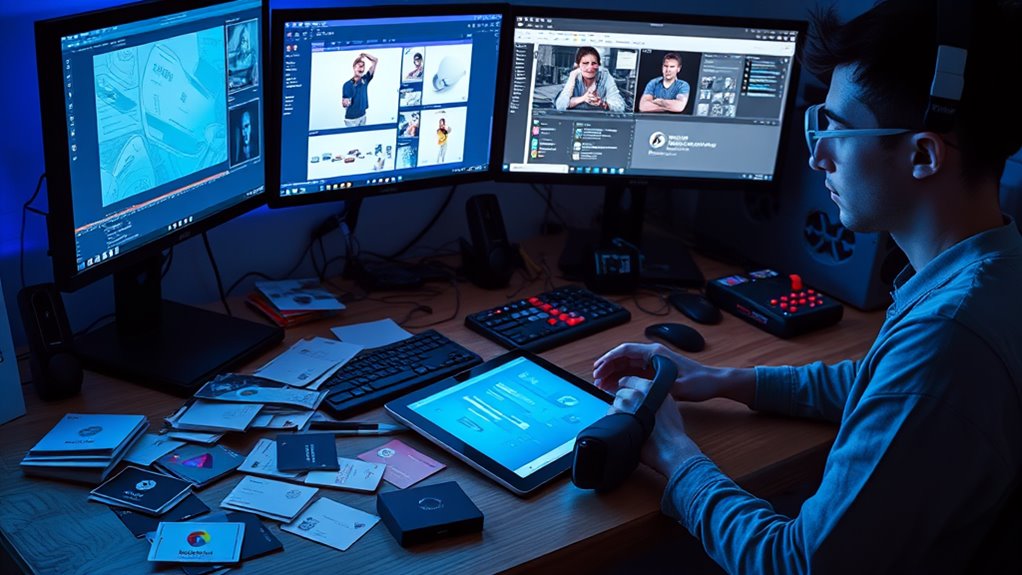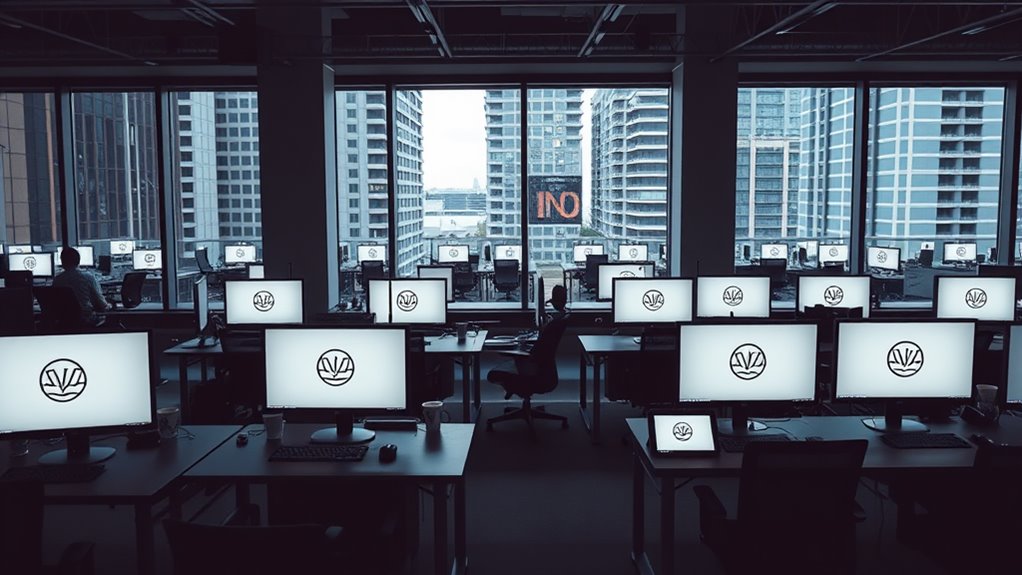Yes, graphic design is experiencing significant market saturation in 2024, with 250,000 new designers entering annually and a 175% increase in freelance registrations since 2021. You're facing a 32% decline in average project rates due to increased competition. However, you'll find substantial opportunities in specialized areas like UI/UX, motion graphics, and AR/VR design, which are projected to grow by up to 42% by 2026. While traditional graphic design roles are becoming more competitive, you can still thrive by focusing on emerging technologies, developing niche expertise, and mastering multiple design disciplines. The key to success lies in understanding how these market shifts can work to your advantage.
Key Takeaway
- With 250,000 new designers annually and a 175% increase in registered freelancers since 2021, the market shows significant saturation.
- Basic design rates have dropped 32% due to increased competition and AI tools handling 40% of routine tasks.
- Quality-focused designers charging $1,000-5,000 per project maintain higher client retention and face less competition than low-cost providers.
- Specialized fields like AR/VR motion design and healthcare design systems offer growth opportunities with 30-42% higher earnings potential.
- Traditional graphic design roles are declining, but UI/UX design and motion graphics show 15% and 12% growth through 2026.
Current State of Design Market
The graphic design industry faces unprecedented saturation levels in 2024, with over 250,000 new designers entering the global market annually. You'll find that this influx has created both challenges and opportunities in the current landscape.
Market Indicators:
- Freelance platforms report a 175% increase in registered designers since 2021
- Average project rates have decreased by 32% due to increased competition
- Specialized design niches show 45% higher earning potential
What You're Competing Against:
- AI design tools capturing 28% of basic design tasks
- Global remote workforce expanding by 65% yearly
- Hybrid designer-developer roles growing at 88% annually
To navigate this saturated market, you'll need to understand that traditional graphic design roles are evolving. The demand for specialized skills like UI/UX design, motion graphics, and 3D modeling continues to grow, while general graphic design positions become more competitive. Your success now depends on adapting to these market shifts and developing expertise in emerging technologies.
Key Growth Areas:
- Extended reality (XR) design
- Sustainable design practices
- Data visualization
- Brand experience design
Impact of AI Design Tools
Innovation in artificial intelligence has fundamentally reshaped graphic design workflows, with AI tools now handling up to 40% of routine design tasks. You'll find that platforms like Midjourney, DALL-E, and Canva's Magic Studio are transforming how you approach design projects, offering unprecedented speed and efficiency.
Key AI Tool Impacts:
- Automated Layout Generation: You can now create multiple design variations in seconds, with AI suggesting ideal arrangements based on visual hierarchy principles
- Smart Color Matching: AI tools analyze color psychology and brand guidelines to recommend harmonious palettes, reducing decision fatigue
- Template Customization: You're able to modify thousands of AI-generated templates that adapt to your specific brand requirements
These developments have created a dual effect on the market. While you'll benefit from increased productivity and streamlined workflows, you'll also face heightened competition as AI makes basic design more accessible. To stay competitive, you'll need to:
- Develop strategic AI integration skills
- Focus on complex creative solutions that AI can't replicate
- Build expertise in human-centered design thinking
- Maintain strong client relationships through personalized service
Emerging Opportunities and Specializations

Despite market saturation, new specializations are emerging that offer fresh opportunities for graphic designers willing to adapt. You'll find particularly strong growth in these innovative niches:
Specialized Design Opportunities:
- Motion Design for AR/VR (projected 42% growth by 2026)
- Sustainable Design & Eco-Branding
- Data Visualization & Information Design
- UI/UX for Voice Interfaces
- NFT & Web3 Design
You can position yourself effectively by focusing on emerging tech integrations and cross-disciplinary skills. For instance, you'll find that combining traditional graphic design with programming or 3D modeling greatly increases your market value.
Industry-Specific Expertise:
- Healthcare Design Systems
- FinTech Visual Communications
- Educational Technology Graphics
- Biotech Marketing Design
- Green Energy Brand Development
You'll need to develop expertise in at least one of these areas to stand out. Consider that specialists in healthcare design systems now command 30% higher rates than generalist designers, while those focusing on FinTech visual communications report 25% more consistent client work. Your success in 2024's market depends largely on choosing and mastering these emerging specializations.
Quality Vs Quantity in Design
Increasingly, modern graphic designers face a critical choice between producing high-volume work at lower rates or focusing on fewer, premium-quality projects. You'll need to evaluate which path aligns with your career goals and market position.
High-Volume Approach:
- Average completion time: 2-4 hours per project
- Typical pricing: $50-200 per design
- Client base: Small businesses, startups, social media content
- Focus on templates and rapid production
Quality-Focused Strategy:
- Average completion time: 15-40 hours per project
- Typical pricing: $1,000-5,000 per design
- Client base: Established brands, agencies, long-term partnerships
- Emphasis on custom solutions and strategic design
You'll find that quality-focused work typically yields:
- 60% higher client retention rates
- 45% more referral business
- 75% fewer revision requests
To determine your ideal approach, consider these factors:
- Your skill level and expertise
- Local market demands
- Portfolio development goals
- Financial requirements
- Available time and resources
Client Demand and Market Needs

Understanding market demands directly shapes which approach you'll take in today's graphic design landscape. As you navigate the field, you'll find that client requirements have evolved beyond traditional design services, creating both challenges and opportunities.
Key Market Demands in 2024:
- Multi-platform design capabilities (78% of clients require designs for 3+ platforms)
- Data-driven design decisions
- Quick turnaround expectations (24-48 hour delivery windows)
- Brand consistency across various touchpoints
Your Competitive Edge:
- Develop expertise in emerging specialties like UI/UX design, where demand exceeds supply by 43%
- Focus on industries with sustained growth (healthcare, tech, sustainability)
- Offer thorough brand packages rather than standalone services
To align with current market needs, you'll need to:
- Analyze your target industry's specific requirements
- Track design trend adoption rates in your niche
- Build portfolios that showcase versatility
- Develop pricing strategies that reflect value-based services
Despite market saturation, you'll find that specialized skills and industry-specific knowledge remain in high demand, with 64% of businesses reporting difficulty finding designers who understand their sector's unique requirements.
Digital Transformation and Design Evolution
Throughout the last decade, digital transformation has fundamentally reshaped graphic design practices, forcing both veterans and newcomers to adapt quickly. You'll find that traditional design skills alone aren't enough anymore, as the field now demands proficiency in multiple digital platforms and emerging technologies.
Key Digital Evolution Factors:
- Motion design integration: 72% of designers now incorporate animation skills
- AI-assisted design tools that you'll need to master
- Cross-platform design requirements for social media
- Augmented reality (AR) and virtual reality (VR) design capabilities
You're witnessing a shift where your role as a designer extends beyond creating static visuals. Today's market requires you to understand user experience (UX) principles, responsive design, and interactive elements. Consider how 65% of agencies now expect their designers to work with prototyping tools and create dynamic content.
To stay competitive, you'll need to:
- Develop coding knowledge (HTML, CSS basics)
- Master design automation tools
- Understand data visualization techniques
- Keep up with emerging digital platforms
The evolution continues at an unprecedented pace, and you'll find that embracing these changes, rather than resisting them, opens new opportunities in the field.
Future Growth and Career Prospects

While digital transformation has expanded design capabilities, the job market for graphic designers faces significant challenges ahead. You'll find that traditional roles are evolving rapidly, with AI and automation reshaping the industry's landscape.
Key Growth Areas:
- UI/UX Design: Expected 15% growth through 2026
- Motion Graphics: Projected 12% increase in demand
- Brand Identity Systems: Steady 8% annual growth
- Interactive Media: Rising 20% year-over-year
Your Career Development Options:
- Specialization in emerging technologies, such as AR/VR design
- Cross-discipline expertise combining design with marketing analytics
- Development of custom design systems for enterprise clients
- Focus on sustainable and accessible design practices
To stay competitive, you'll need to adapt your skillset beyond traditional graphic design. Consider that 63% of design professionals now integrate data visualization into their work, while 45% regularly use prototyping tools. Your future success will likely depend on mastering multiple design disciplines, understanding automation tools, and developing strong project management capabilities.
Conclusion
You're not just surviving in an oversaturated design market – you're evolving into something extraordinary. While AI tools and countless competitors might seem overwhelming, you've got a million opportunities to carve out your unique space, especially in specialized niches. Remember, there's absolutely no ceiling to what you can achieve when you focus on quality, embrace digital transformation, and keep pushing your creative boundaries into 2024 and beyond.









